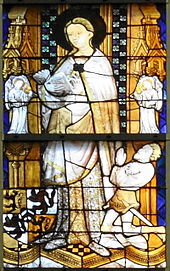Wilhelm II (mountain)

Wilhelm II. Von Berg (* around 1348; † June 24, 1408 in Düsseldorf ) was Count von Berg from 1360 and as Wilhelm I Count of Ravensberg , from 1380 as Wilhelm I Duke of Berg.
history
family
Wilhelm was the only son of Count Gerhard von Berg from the Jülich (-Heimbach) family and Margarete von Ravensberg-Berg . In 1360 he married Anna von der Pfalz , daughter of Elector Ruprecht II. Von der Pfalz . From his sons Ruprecht , Gerhard, Adolf and Wilhelm he provided Adolf and Wilhelm one after the other with the county of Ravensberg; He also helped Ruprecht († 1394) and Wilhelm to be elected bishop in Paderborn . His daughter Beatrix von Berg (1360-1395) married the Elector Ruprecht I (Palatinate) in 1385 and thereby became Electress. She was buried in a prominent place in the collegiate church of Neustadt an der Weinstrasse ; The grave and epitaph are preserved there. His other daughter Margareta (1360–1442) married Otto the Quaden of Braunschweig-Göttingen .
Domination
Under Wilhelm's rule, the county of Berg was elevated to a duchy and Fahnlehen . At the Reichstag in Aachen on May 24, 1380, King Wenzel Wilhelm conferred the title of duke and accepted him into the imperial prince's rank . Wilhelm was thus granted the right to lead the royal horse by the reins during campaigns. In addition, he was accepted into a friendship alliance by King Wenzel alongside the dukes of Jülich and Geldern and later appointed councilor and housemate by Emperor Charles IV .
In the course of his reign he bought some parishes at Agger and Sieg and also got Blankenberg . For this he had to pledge the lordship of Hardenberg and the city of Kaiserswerth in 1368 .
From 1386, Duke Wilhelm I moved into his new residence in Düsseldorf , which was able to initiate development into a state capital through the settlement of a ducal court . Wilhelm had a castle built on the Rhine there . The previously small parish church of Düsseldorf, St. Lambertus , was enlarged to a hall church and equipped with benefices and relics. The city was also built princely.
Wars
He waged war against Counties Mark and Kleve , also to prevent the unification of the two countries, but was taken prisoner with his entire army at the Battle of Kleverham on June 7, 1397. Although he was able to buy himself and his followers free, he had to pledge large parts of his dominion. His sons Adolf, Gerhard and Wilhelm saw their inheritance threatened and openly rebelled against their father. They forced some areas from themselves. Adolf finally attacked his father at Monheim on November 28, 1403 and imprisoned him until August 1404. On August 24, 1404, Wilhelm was freed from loyal people from Burg Castle and on July 2, 1405, with the help of King Ruprecht, he was able to assert himself in the question of rule. Nevertheless, he largely left the rule over Berg to his son Adolf.
tomb
Wilhelm died in Düsseldorf in 1408. The burial site cannot be clearly identified. However, there is a grave slab for him in Altenberg Cathedral . It can be assumed that he and his son were buried there.
literature
- Götz J. Pfeiffer: The art foundations of Duke Wilhelm I. von Berg around 1400. Contribution to the report on the autumn conference of the Department for Rhenish Regional History of the Institute for Historical Science of the University of Bonn on October 5th and 6th, 2009: "Seelenheil - Gemeinwohl - Ansehen. Donors and foundations in the Rhineland from the Middle Ages to the present. In: Rheinische Vierteljahresblätter, 74, 2010, p. 448.
- Götz J. Pfeiffer: The painting on the Lower Rhine and in Westphalia around 1400. The master of the Berswordt retable and the style change of the time . Petersberg, 2009, pp. 26-35.
- Götz J. Pfeiffer: Giving for fame and soul. The art foundations of the first Bergisch duke couple Wilhelm von Jülich († 1408) and Anna von Bayern († 1415). In: Rheinisch Bergischer Calendar, 78, 2008, pp. 8-19.
- Götz J. Pfeiffer: Princely gift and design by a panel painter. Wilhelm von Jülich and Anna von Bayern commissioned the master of the Berswordt retable with their foundation for the Altenberger Westfenster. In: Altenberger Blätter. Special issue “The Altenberger Westfenster”, August 2006, pp. 13–74.
- Götz J. Pfeiffer: "... with God's help they escaped their violence". The trip to Prussia of Wilhelm von Jülich, Count von Berg and Ravensberg, in the summer of 1366. In: Zeitschrift des Bergisches Geschichtsverein , 101, 2005–2007, pp. 1-20.
- Axel Kolodziej : Duke Wilhelm I von Berg (1380-1408). from the series: Bergische Forschungen . Published on behalf of the Bergisches Geschichtsverein and its Scientific Commission, Volume XXIX. Publishing house Schmidt: Neustadt an der Aisch 2005. ISBN 3-87707-639-4 .
- Axel Kolodziej: On the anniversary of the death of Duke Wilhelm I von Berg - June 24, 1408. In: Romerike Berge, 58 Jg., Issue 1, 2008, pp. 9-19. ISSN 0485-4306 .
- Karl vom Berg, Wilhelm fullness: Bergische princes and homeland pictures. Düsseldorf and Elberfeld 1926.
Web links
| predecessor | Office | successor |
|---|---|---|
| Gerhard |
Count von Berg from 1380, Duke 1360–1405 |
Adolf |
| Gerhard |
Count of Ravensberg 1360–1395 |
Adolf |
| personal data | |
|---|---|
| SURNAME | Wilhelm II. |
| ALTERNATIVE NAMES | Wilhelm I. |
| BRIEF DESCRIPTION | Duke of Berg |
| DATE OF BIRTH | around 1348 |
| DATE OF DEATH | June 24, 1408 |
| Place of death | Dusseldorf |
